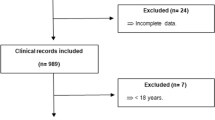Abstract
Introduction and hypothesis
This study aims to evaluate the association between pelvic floor muscle (PFM) strength and sexual functioning.
Methods
Retrospective chart review of consecutive all women who were referred with a primary complaint of sexual dysfunction. Women underwent standardized clinical evaluation including pelvic muscle strength which was ranked from 0 (weak) to 2 (strong). The duration of pelvic muscle contraction was also recorded in seconds. Sexual function was evaluated by using a validated questionnaire, the Female Sexual Function Index (FSFI).
Results
One hundred seventy-six women with a mean age of 37 ± 11 years were included. Women with strong or moderate PFM scored significantly higher on the FSFI orgasmic and arousal domains than women with weak PFM (5.4 ± 0.8 vs. 2.8 ± 0.8, and 3.9 ± 0.5 vs. 1.7 ± 0.24, respectively; P < 0.001). The duration of PFM contraction was correlated with FSFI orgasmic domain and sexual arousal (r = 0.26, P < 0.001; r = 0.32, P < 0.0001, respectively).
Conclusions
Our findings suggest that both the orgasm and arousal function are related to better PFM function.
Similar content being viewed by others
Abbreviations
- PFM:
-
pelvic floor muscle
- PFMT:
-
pelvic floor muscle training
- MVC:
-
maximum voluntary contraction
- FSFI:
-
Female Sexual Function Index
- SD:
-
sexual dysfunction
References
Graber B, Kline-Graber G (1979) Female orgasm: role of pubococcygeus muscle. J Clin Psychiatry 40(8):348–351
Kinsey A, Pomeroy W, Martin C, Paul G (1998) Sexual behavior in the human female. W. B. Saunders, Philadelphia
Bo K, Talseth T, Vinsnes A (2000) Randomized controlled trial on the effect of pelvic floor muscle training on quality of life and sexual problems in genuine stress incontinent women. Acta Obstet Gynecol Scand 79(7):598–603
Beji NK, Yalcin O, Erkan HA (2003) The effect of pelvic floor training on sexual function of treated patients. International urogynecology journal and pelvic floor dysfunction 14(4):234–238, discussion 238
Zahariou AG, Karamouti MV, Papaioannou PD (2008) Pelvic floor muscle training improves sexual function of women with stress urinary incontinence. International urogynecology journal and pelvic floor dysfunction 19(3):401–406
Messe MR, Geer JH (1985) Voluntary vaginal musculature contractions as an enhancer of sexual arousal. Arch Sex Behav 14(1):13–28
Achtari C, Dwyer PL (2005) Sexual function and pelvic floor disorders. Best practice & research 19(6):993–1008
Foldes P, Buisson O (2009) The clitoral complex: a dynamic sonographic study. The journal of sexual medicine 5:1223–1231
Kegel AH (1952) Sexual functions of the pubococcygeus muscle. West J Surg Obstet Gynecol 60(10):521–524
Shafik A (2000) (2000) The role of the levator ani muscle in evacuation, sexual performance and pelvic floor disorders. International urogynecology journal and pelvic floor dysfunction 11(6):361–376
Rosen R, Brown C, Heiman J, Leiblum S, Meston C, Shabsigh R et al (2000) The Female Sexual Function Index (FSFI): a multidimensional self-report instrument for the assessment of female sexual function. J Sex Marital ther 26(2):191–208
Helstrom L, Nilsson B (2005) Impact of vaginal surgery on sexuality and quality of life in women with urinary incontinence or genital descensus. Acta Obstet Gynecol Scand 84(1):79–84
Ghezzi F, Serati M, Cromi A, Uccella S, Triacca P, Bolis P (2006) Impact of tension-free vaginal tape on sexual function: results of a prospective study. International urogynecology journal and pelvic floor dysfunction 17(1):54–59
Laycock JSB, Norton P, Stanton S (1994) Pelvic floor re-education: principles and practice. Springer, London
Bo K, Sherburn M (2005) Evaluation of female pelvic-floor muscle function and strength. Phys Ther 85(3):269–282
Conflicts of interest
None.
Author information
Authors and Affiliations
Corresponding author
Rights and permissions
About this article
Cite this article
Lowenstein, L., Gruenwald, I., Gartman, I. et al. Can stronger pelvic muscle floor improve sexual function?. Int Urogynecol J 21, 553–556 (2010). https://doi.org/10.1007/s00192-009-1077-5
Received:
Accepted:
Published:
Issue Date:
DOI: https://doi.org/10.1007/s00192-009-1077-5



